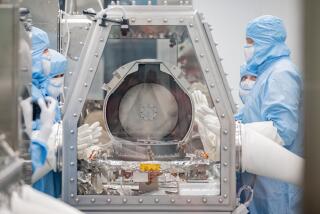Galileo Spacecraft Explores Asteroid on Jupiter Trek
- Share via
After a hellish week with the apparently doomed Mars Observer probe, NASA finally got some good news Saturday as the handicapped Galileo spacecraft explored asteroid Ida on its way to Jupiter.
“We feel wonderful and greatly relieved,” said Bill O’Neil, project manager of the $1.4-billion Galileo mission run by NASA’s Jet Propulsion Laboratory in Pasadena. “I really feel good having this past us and having a big plus mark today following not-so-good news earlier in the week.”
Galileo, hampered by a jammed main antenna, made its successful exploration of Ida a week after the National Aeronautics and Space Administration lost touch with Mars Observer as that spacecraft neared the Red Planet on the first U.S. Martian exploration in 17 years.
Despite last-ditch efforts to restore contact, the $980-million Mars mission appears to be over.
Galileo zoomed about 1,491 miles from Ida--a 20-mile-long, irregularly shaped asteroid--at 9:52 a.m. Saturday, NASA spokesman Jim Wilson said. Radio signals confirming that the flyby occurred took half an hour to travel 334 million miles to Earth.
It was only the second time a spacecraft visited an asteroid. Galileo made the first such exploration in 1991, when it swept within 995 miles of asteroid Gaspra.
A glitch four hours before Galileo’s close encounter with Ida meant that the spacecraft failed to take three of 21 planned photographs, but they were the longest-distance photos and unimportant compared to the close-ups, O’Neil said.
He was confident that Galileo captured the best pictures, although it will be next month before the first two pictures are sent to Earth. The others will be transmitted in spring.
Galileo, launched from a shuttle in 1989, has its biggest challenge ahead: exploring Jupiter for two years starting in December, 1995.
The spacecraft is hampered because its main antenna, which should look like an upside-down umbrella, failed to fully open two years ago. Efforts to fix it failed. So Galileo must dribble pictures and data to Earth using a small antenna. That means 30% of the mission’s scientific goals at Jupiter may not be met, O’Neil has said.
Galileo Visits Second Asteroid
* Space probe passes 1,491 miles from Ida on Saturday, traveling at a speed of 28,000 miles per hour.
* Closest approach at 9:52 a.m. PDT, but a signal from the probe takes nearly half an hour to travel the 334 million miles back to Earth.
* Galileo’s camera programmed to take 21 pictures of the asteroid. Two will be radioed back to Earth in September, the rest next spring. Damaged main antenna means pictures take up to 30 hours each to transmit.
Earth encounters: 1990 and 1992
Launch from Earth: Oct. 1989
Venus encounter: Feb. 1990
Gaspra: Oct. 1991
Destination: Jupiter / Dec. 1995
Jammed main antenna
How antenna would look if correctly extended
Source: Jet Propulsion Laboratory, Sky & Telescope magazine
More to Read
Sign up for Essential California
The most important California stories and recommendations in your inbox every morning.
You may occasionally receive promotional content from the Los Angeles Times.












